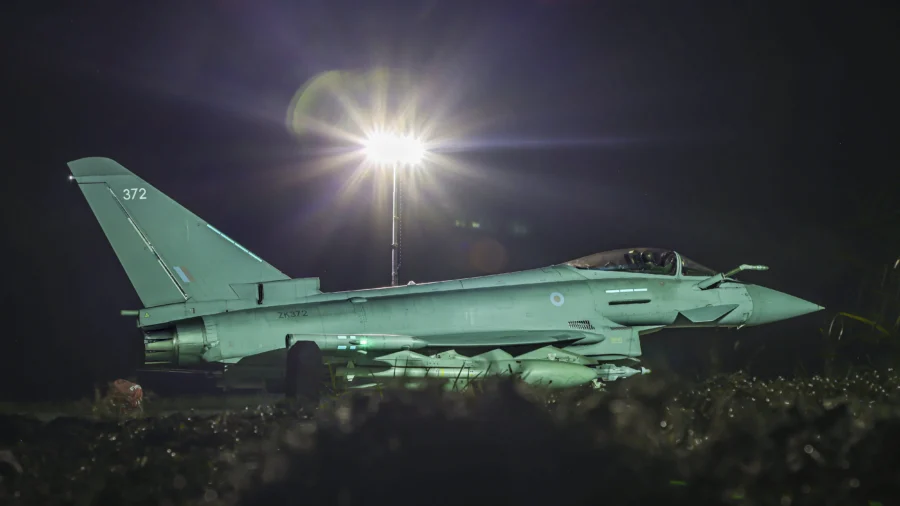A drone attack on a U.S. military installation in eastern Syria has reportedly killed at least six fighters linked to the Syrian Democratic Forces (SDF), a Kurdish-led fighting force aligned with the United States.
“Six of our fighters were martyred in a terrorist attack by a suicide drone originating from areas controlled by Syrian regime mercenaries,” the SDF said in a Feb. 5 statement.
According to the SDF, the attack—which occurred just after midnight—targeted a training camp near the al-Omar oilfield east of the Syrian city of Deir al-Zour.
The Syrian Observatory for Human Rights, a United Kingdom-based monitoring group, put the number of slain SDF fighters at seven, with another 18 injured.
No casualties among U.S. personnel have thus far been reported, while U.S. officials have yet to release a statement on the purported attack.
Armed and supported by the U.S. military, the Kurdish-led SDF was formed in 2015 to fight the ISIS terrorist group.
Since 2015, the United States has maintained a military presence in eastern Syria, currently estimated at some 900 troops.
Damascus, like its ally Tehran, views the presence of U.S. forces in Syria as an “illegal occupation.”
It also considers the SDF as a U.S. proxy force in the region and a terrorist group.
The SDF blamed Iran-backed extremist groups for the attack on the base in eastern Syria.
“Preliminary investigations confirm that Iran-backed militias were behind the terrorist drone attack on our forces in the al-Omar oilfield,” the group stated in a social media post.
The SDF asserted its right to respond to attacks on its personnel.

First Attack since US Barrage
The reported attack in eastern Syria was the first of its kind since the United States conducted a series of wide-ranging strikes on Syrian and Iraqi targets on Feb. 2.
According to U.S. officials, the attacks hit more than 85 targets linked to Iran’s Revolutionary Guard Corps and Iran-backed militia groups operating in the region.
Syria’s defense ministry later claimed that the strikes had killed an unspecified number of Syrian soldiers and civilians.
“The occupation of Syrian territory by U.S. forces cannot continue,” the ministry said in a statement.
“The Syrian military … is determined to liberate all Syrian territory from terrorism and occupation,” it added.
Iraq’s military, for its part, warned that the U.S. strikes would only serve to destabilize an already volatile Middle East.
Iraqi army spokesman Yahya Rasool said the strikes were a “violation of Iraq’s sovereignty” and would likely have “dire consequences … for the entire region.”
The extensive barrage was aimed at Iran-backed militia groups that have carried out a spate of recent attacks on U.S. forces in Iraq, Syria, and Jordan.
The groups said the attacks are a response to Israel’s offensive in the Gaza Strip that has left thousands of Palestinians dead—mostly civilians—since early October.
According to the Pentagon, U.S. forces deployed in the region have come under attack more than 165 times since Israel began its offensive in Gaza.
Most attacks, including the latest in eastern Syria, have been claimed by the self-styled Islamic Resistance in Iraq, an umbrella group of mostly Shiite militia outfits.
Along with an end to Israel’s offensive in Gaza, the group demands the immediate withdrawal of all U.S. forces from Syria and Iraq.
Last week, it claimed responsibility for an attack on a U.S. base in northeastern Jordan that left three U.S. military personnel dead and dozens more injured.
Although the attack occurred inside Jordan, a longstanding U.S. ally, the targeted base—known as Tower 22—sits adjacent to both the Iraqi and Syrian borders.

US Threatens More Strikes
On Feb. 3, the United States and Britain also conducted wide-ranging strikes against dozens of targets linked to Yemen’s Houthi terrorist group.
Closely linked to Iran, the group (also known as Ansar Allah) has staged repeated attacks on ships traversing the Red Sea—commercial and military—in response to Israel’s ongoing offensive in Gaza.
Attacks by the Houthis have severely disrupted maritime traffic throughout the region, and have taken a toll on international commerce.
According to U.S. Central Command, the latest round of U.S.-British strikes targeted Houthi-operated missile launchers that had “presented an imminent threat to U.S. Navy ships and merchant vessels in the region.”
Jake Sullivan, the White House national security adviser, has warned of the possibility of further strikes against Iran-linked groups in the region.
“We intend to take additional strikes, and additional action, to continue to send a clear message that the United States will respond when our forces are attacked, when our people are killed,” he said in televised remarks on Feb. 4.
On Feb. 5, U.S. Secretary of State Antony Blinken arrived in Saudi Arabia for the first leg of a Middle East tour during which he will hold talks with regional leaders.
Reuters contributed to this report.
From The Epoch Times

